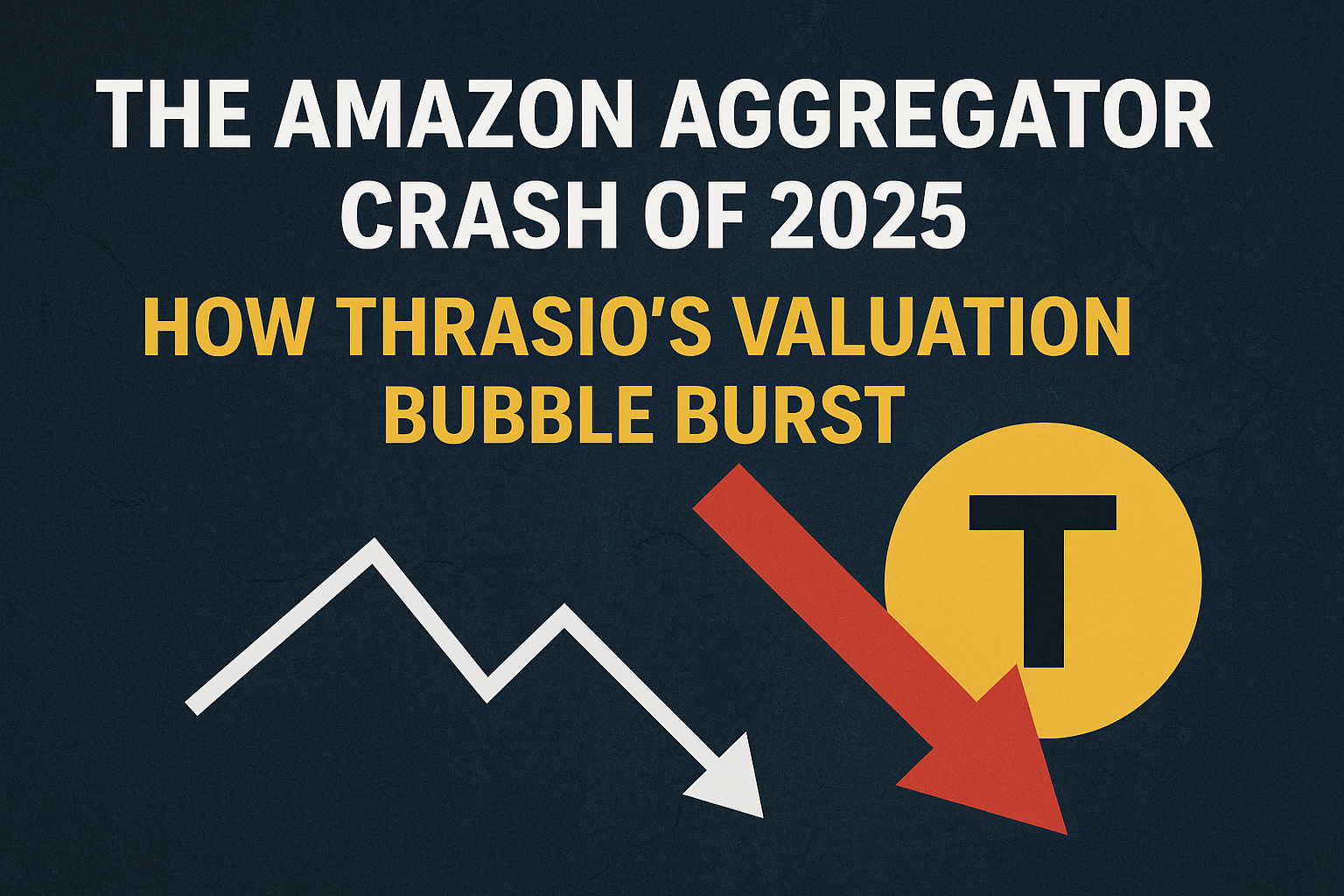Address
304 North Cardinal St.
Dorchester Center, MA 02124
Work Hours
Monday to Friday: 7AM - 7PM
Weekend: 10AM - 5PM

The 2020–2021 e-commerce gold rush saw Amazon aggregators like Thrasio raise $12.3 billion in funding, promising sellers 5–7x EBITDA multiples for quick exits. By 2025, however, 87% of these aggregators had either collapsed or undergone restructuring. Thrasio’s bankruptcy—with $1.2 billion in debt and 200+ failed acquisitions—exposed a harsh reality: valuation bubbles, reckless acquisitions, and operational missteps can destroy even the most promising business models.
For U.S.-based Amazon sellers and eCommerce brands, understanding this cycle is critical. Whether you’re considering selling your business or scaling through acquisitions, the lessons from Thrasio’s rise and fall offer invaluable insights into discipline, capital efficiency, and operational excellence.
Amazon aggregators aimed to consolidate third-party sellers into portfolios, leveraging economies of scale to streamline operations, boost margins, and accelerate growth. Thrasio pioneered this approach, raising over $3 billion in 2021 alone and acquiring 200+ brands. Investors bet on multiples of 5–7x EBITDA for sellers with proven Amazon track records.
But beneath the surface, cracks formed rapidly:
The aggregator boom coincided with a historic capital bubble fueled by:
Thrasio’s co-founder, John Hefter, admitted in a 2025 interview: “We started paying 2x EBITDA for quality brands. By 2021, we were paying 7x for ‘Chinese vaporware garbage’ just to hit growth targets.”
Marketplace Pulse data confirms this:
The result? A death spiral of overleveraged portfolios and unrealistic expectations.
Thrasio’s downfall wasn’t due to a flawed model—it was due to execution under extreme conditions. Key mistakes included:
Competition forced aggregators to buy brands with declining margins, niche products, or compliance issues. Many required heavy reinvestment just to maintain sales. By 2024, Thrasio had written down over $500 million in “goodwill” from failed acquisitions.
Thrasio scaled from 4 founders to 1,600 employees in 2.5 years, acquiring 200 brands. But rapid growth led to:
While the number of active Amazon sellers declined, the number generating $1M+ in annual revenue grew to 120,000+. Aggregators found themselves competing against battle-tested sellers with deeper pockets and better data insights.
“Some aggregators were worse at running Amazon businesses than the sellers they bought,” Hefter noted. “By 2024, many sellers had built their own in-house teams and were less willing to sell.”
Thrasio’s collapse underscores a critical truth: Consolidation works only when operational execution matches ambition.
Contrast Thrasio’s fate with software aggregators like Threecolts ($200M raised) and Carbon6 ($210M sale), which thrived by:
For physical goods aggregators, operational excellence requires:
Stick to 2–3x EBITDA multiples for proven brands, avoiding “growth at all costs” traps. By 2025, the most successful aggregators are those that waited out the bubble and now acquire at rational prices.
Use AI to streamline inventory forecasting, ad optimization, and customer service. Thrasio’s manual processes couldn’t keep pace with portfolio complexity. Modern aggregators are investing in proprietary tech stacks to automate 80% of routine tasks.
Ensure acquired teams share a playbook. Hybrid models (e.g., keeping original founders on board) can preserve expertise. By 2025, the best aggregators treat acquisitions as partnerships rather than takeovers.
Despite the carnage, the aggregator model isn’t dead—it’s evolving. Success now demands:
Hefter believes the model could revive at 2x multiples with better tech infrastructure. But the bar is higher: Amazon sellers are more sophisticated, and platform algorithms reward agility over scale.
Ready to scale your Amazon business without repeating Thrasio’s mistakes? Our team specializes in data-driven acquisition strategies and operational optimization for eCommerce brands. Contact us today for a free portfolio audit and discover how to maximize growth while minimizing risk.
An Amazon aggregator acquires and consolidates third-party seller businesses on Amazon, aiming to streamline operations and boost profits through shared infrastructure.
Thrasio collapsed due to overpaying for low-quality assets during a capital bubble, rapid scaling without operational discipline, and competition from sophisticated sellers. By 2024, the company had burned through most of its cash reserves and was forced into bankruptcy.
Yes, but only with disciplined valuations (2–3x EBITDA), operational excellence, and niche specialization. Software aggregators focusing on Amazon seller tools have proven more resilient. By 2025, the most successful aggregators are those that survived the 2021–2024 bubble and now operate with lean teams and rational acquisition strategies.